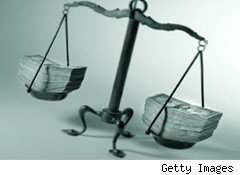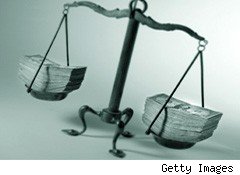 While most of us were alive 20 years ago, peoples’ memories of the savings and loan crisis of the early 1990s have faded. But more than 1,000 so-called savings & loans — banks specifically set up to lend out their deposits to people buying houses — failed in the late 1980s and early 1990s due to a change in regulation that permitted S&Ls to take big risks. Bailing them out ultimately cost the federal government $220 billion.
While most of us were alive 20 years ago, peoples’ memories of the savings and loan crisis of the early 1990s have faded. But more than 1,000 so-called savings & loans — banks specifically set up to lend out their deposits to people buying houses — failed in the late 1980s and early 1990s due to a change in regulation that permitted S&Ls to take big risks. Bailing them out ultimately cost the federal government $220 billion.
By contrast, bailing out Wall Street and the U.S. auto industry through the Troubled Asset Relief Program from the recent crisis is expected, when all is tallied, to cost the government $105 billion — or maybe $11 billion less if the TARP gets shut down three months early to satisfy concerns Sen. Scott Brown (R-Mass.) had about the pending financial reform bill, according to .
Does that mean that the current financial crisis was half as bad? Not bloody likely.
S&L Bailout 101
As a quick refresher, the S&L crisis sprang from the passage in 1982 under President Ronald Reagan of The Garn-St. Germain Act — which freed S&Ls to make risky loans, eliminate deposit caps, and hold less capital. S&Ls used their new freedom to pay higher rates to depositors and invested those new deposits in commercial real estate projects and junk bonds.
While they earned high up-front fees for the S&Ls, these investments ultimately collapsed, leaving about a thousand insolvent S&Ls. Reagan’s successor, George H.W. Bush, had the pleasure of overseeing what was then the biggest bailout in U.S. history — the $220 billion S&L bailout, according to nonprofit news company ProPublica.
Compared to the S&L bailout, the recent financial crisis is looking like a bargain. Treasury is now forecasting that TARP will cost far less than the S&L crisis did. The reports that a mere $386 billion worth of TARP money was actually spent (a bit more than half the original $700 billion authorized). Big banks have repaid roughly half of that $386 billion.
And the TARP losses are not likely to come from Wall Street — the originally intended recipients of the government funds — but from the auto industry, which got $80 billion from the program, and insurance giant American International Group (AIG), which received $48 billion from TARP — and another $134.3 billion from other government programs.
A Failure to Learn the Lessons of Deregulation
What both the S&L crisis and current financial crisis share are their root causes: Clever manipulation of the banking system that allowed financial firms to reap huge profits while shifting the risks, and ultimately the costs, onto taxpayers. Deregulation allowed S&Ls to deviate dramatically from their fiscally conservative missions, and that deviation led them to create all sorts of investments that purported to generate higher returns but were really just bad deals.
The current financial crisis springs from many sources — not the least of which are government’s failure to limit Wall Street borrowing, to cut the financial ties between ratings agencies and investment banks, and to put bankers’ pay in escrow so they can get rewarded or punished based on the long-term performance of the deals they close.
But as I wrote back in December 2007 on sister site, , the current financial crisis is above all the first one that sprang from securitization. It was those bundles of securities backed by mortgages — many of which were sub-prime — that ultimately ended up being impossible to price in a cash crisis that caused so much grief. Like commercial real estate in the 1980s, securitization was seen as a safe way to get high returns — until things went bust, and the securities’ values plunged far below what bankers had predicted.
Weighing the Ultimate Cost
While the cash cost to taxpayers of bailing out the current financial crisis may indeed be less than that of the S&L crisis, both created all sorts of collateral damage. The U.S. had a nasty recession in the early 1990s, and a far nastier one started in December 2007. Both downturns threw people out of work and cut the market values of their houses and stocks.
The hardest part of thinking about both crises is that we still have not learned their two most important lessons. That’s because the financial reform bill doesn’t take the two key steps that would adjust the system to prevent another similar crisis: limiting Wall Street borrowing, and linking banker compensation to both return and risk.
Until our laws reflect those lessons, we are doomed to repeat the mistakes of economic history.


Leave a Reply